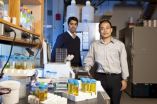(Press-News.org) WALNUT CREEK, Calif.—A tiny crustacean that has been used for decades to develop and monitor environmental regulations is the first of its kind to have its genetic code sequenced and analyzed—revealing the most gene-packed animal characterized to date. The information deciphered could help researchers develop and conduct real-time monitoring systems of the effects of environmental remediation efforts.
Considered a keystone species in freshwater ecosystems, the waterflea, Daphnia pulex, is roughly the size of the equal sign on a keyboard. Its 200 million-base genome was described in the February 4 issue of Science, the result of a collaboration between the Daphnia Genomics Consortium and the U.S. Department of Energy (DOE) Joint Genome Institute (JGI) that began nearly a decade ago when environmental agencies and toxicology researchers were looking into aquatic model systems that acted as sentinel species in order to diagnose the presence of problematic chemicals in fresh water and extrapolate their effects.
"Daphnia is one of the most widely used model systems for environmental protection agencies around the world," said project leader and Indiana University Center for Genomics and Bioinformatics genomics director John Colbourne. "The costly challenge of evaluating conditions in the environment and of our water supplies may be overcome by Daphnia's potential use as a high-tech and modern version of the mineshaft canary. An early detector of environmental risks should produce diagnostic and robust signals of the test-animal's response to stress. Our initial studies revealed that Daphnia's genes are evolved to be fine-tuned to environmental changes."
The ability to use Daphnia for environmental studies focused on identifying associations between gene function and disease also contributed to the recent inclusion of Daphnia as a model system for biomedical research by the National Institutes of Health, joining established models like the fruit fly Drosophila and the worm C. elegans. Colbourne said that the Daphnia Genomics Consortium is working on improving techniques to do large-scale genome population assays to better track and manage remediation applications.
Aside from environmental monitoring, study coauthor Michael Pfrender of the University of Notre Dame noted another application of the Daphnia genome with regard to developing commercial biofuels. "When you grow algae in large open-air tanks to select for biofuel production, they're invaded by Daphnia that graze down the algae," he said. "You're faced with either learning how to control Daphnia or learning how to use it to harvest the hydrocarbons."
The Daphnia project has spawned a large research community that has grown over the course of the project from a handful of founding members to over 450 investigators distributed around the globe. Nearly 200 scientists have contributed published work resulting from the genome study.
The waterflea was sequenced and annotated at the DOE JGI. Igor Grigoriev, head of the DOE JGI Eukaryotic Genomics group, noted that the Daphnia genome, which was sequenced using the Sanger method, is the most compact with over 31,000 genes, a third of which are of unknown function. Grigoriev attributed the large number of genes to expansion by tandem duplication, adding that the number is a conservative estimate. "There are more genes in Daphnia than there are in the human genome, more than any animal," he said.
From the perspective of tracking a species' evolution and development or phylogenetics, the Daphnia genome allows researchers a glimpse at a branch of the Arthropod phylum that had been left out until now when conducting comparative genomic studies without the group. While sequences of arthropods such as the honeybee (Apis mellifera) and the fruit fly (Drosophila melanogaster) are available, there was no representative from the crustaceans in the phylum.
"Crustaceans are the closest living relatives to insects, and Daphnia pulex is the first animal from this group to have its genome completely sequenced", said Jeffrey Boore, who led the portion of this project done at the DOE Joint Genome Institute and is now CEO of Genome Project Solutions, which also made contributions to this study.
Annotating the Daphnia genome also afforded researchers an alternate way of determining gene functions. "This goes beyond having the first crustacean genome," said Grigoriev. "By combining functional genomics assays we can see that the genes of unknown function – the new genes resulting from adaptations, not the ones conserved because they're key for housekeeping – are the most responsive to environmental changes. In that sense, the organism's environment can direct us to areas of interest; if you pick a genome and would like to annotate all the genes, go to the environment."
INFORMATION:
The U.S. Department of Energy Joint Genome Institute, supported by the DOE Office of Science, is committed to advancing genomics in support of DOE missions related to clean energy generation and environmental characterization and cleanup. DOE JGI, headquartered in Walnut Creek, Calif., provides integrated high-throughput sequencing and computational analysis that enable systems-based scientific approaches to these challenges. Follow DOE JGI on Twitter.
Sentinel of change: Waterflea genome to improve environmental monitoring capabilities
2011-02-04
ELSE PRESS RELEASES FROM THIS DATE:
Scripps Research scientists develop powerful new methodology for stabilizing proteins
2011-02-04
La Jolla, CA, February 2, 2011 – Embargoed by the journal Science until February 3, 2011, 2 PM, Eastern time - A team of scientists at The Scripps Research Institute has discovered a new way to stabilize proteins — the workhorse biological macromolecules found in all organisms. Proteins serve as the functional basis of many types of biologic drugs used to treat everything from arthritis, anemia, and diabetes to cancer.
As described in the February 4, 2011 edition of the journal Science, when the team attached a specific oligomeric array of sugars called a "glycan" to ...
Princeton scientists discover mechanism involved in breast cancer's spread to bone
2011-02-04
In a discovery that may lead to a new treatment for breast cancer that has spread to the bone, a Princeton University research team has unraveled a mystery about how these tumors take root.
Cancer cells often travel throughout the body and cause new tumors in individuals with advanced breast cancer -- a process called metastasis -- commonly resulting in malignant bone tumors. What the Princeton research has uncovered is the exact mechanism that lets the traveling tumor cells disrupt normal bone growth. By zeroing in on the molecules involved, and particularly a protein ...
Boosting body's immune response may hold key to HIV cure
2011-02-04
Australian scientists have successfully cleared a HIV-like infection from mice by boosting the function of cells vital to the immune response.
A team led by Dr Marc Pellegrini from the Walter and Eliza Hall Institute showed that a cell signaling hormone called interleukin-7 (IL-7) reinvigorates the immune response to chronic viral infection, allowing the host to completely clear virus. Their findings were released in today's edition of the journal Cell.
Dr Pellegrini, from the institute's Infection and Immunity division, said the finding could lead to a cure for chronic ...
Expectations speed up conscious perception
2011-02-04
The human brain works incredibly fast. However, visual impressions are so complex that their processing takes several hundred milliseconds before they enter our consciousness. Scientists at the Max Planck Institute for Brain Research in Frankfurt am Main have now shown that this delay may vary in length. When the brain possesses some prior information − that is, when it already knows what it is about to see − conscious recognition occurs faster. Until now, neuroscientists assumed that the processes leading up to conscious perception were rather rigid and that ...
Northern hunters slowed down advance of Neolithic farmers
2011-02-04
One of the most significant socioeconomic changes in the history of humanity took place around 10,000 years ago, when the Near East went from an economy based on hunting and gathering (Mesolithic) to another kind on agriculture (Neolithic). Farmers rapidly entered the Balkan Peninsula and then advanced gradually throughout the rest of Europe.
Various theories have been proposed over recent years to explain this process, and now physicists from the University of Girona (UdG) have for the first time presented a new model to explain how the Neolithic front slowed down as ...
Adapting technology to elderly people
2011-02-04
Massive Art Multimedia in Austria and CoSi Elektronik in Germany have a history of collaboration on successful technical projects. A brainstorming session between their developers produced the idea of bringing together many aspects of the modern computing world and applying them specifically to the one group in society that is least likely to already feel those benefits - senior citizens. As with so many projects of this nature, the funding for development was out of reach of two SMEs. By facilitating the funding process EUREKA permitted the development of the project now ...
Death in the bat caves: Disease wiping out hibernating bats
2011-02-04
Conservationists across the United States are racing to discover a solution to White-Nose Syndrome, a disease that is threatening to wipe out bat species across North America. A review published in Conservation Biology reveals that although WNS has already killed one million bats, there are critical knowledge gaps preventing researchers from combating the disease.
WNS is a fatal disease that targets hibernating bats and is believed to be caused by a newly discovered cold-adapted fungus, Geomyces destructans, which infects and invades the living skin of hibernating bats. ...
Using a generic blood pressure and heart drug could save the UK $324 million in 2011
2011-02-04
Using a generic drug to treat hypertension and heart failure, instead of branded medicines from the same class, could save the UK National Health Service (NHS) at least £200 million in 2011 without any real reduction in clinical benefits.
That is the key finding of a systematic review, statistical meta-analysis and cost-effectiveness analysis just published online by IJCP, the International Journal of Clinical Practice.
Researchers from University College London Hospitals NHS Foundation Trust looked at 14 hypertension and heart studies published between 1998 and 2009 ...
Lund adopts chromosome 19
2011-02-04
The genes that make up the human genome were mapped by HUGO, the Human Genome Organisation, and published in 2001. Now the project is expanding into the HUPO, the Human Proteome Organisation. Within the framework of this organisation, many hundreds of researchers around the world will work together to identify the proteins that the different genes give rise to in the human body.
"The 'proteome', the set of all human proteins, is significantly more complicated than the genome. There are over 20 000 proteins coded by the genome in the human body and each protein can have ...
Current use of biodiesel no more harmful than regular diesel
2011-02-04
Up to seven per cent biodiesel blended in regular diesel will presumably not cause greater health risks for the population than the use of pure fossil diesel. This is the main conclusion in a memorandum from the Norwegian Institute of Public Health and the Climate and Pollution Control Agency (formerly SFT) to the Ministry of Health and Care Services and the Ministry of the Environment in Norway.
"A higher content of biodiesel (up to 20 per cent) requires more research to assess health effects. This must include different types of biofuels and blending ratios, as well ...




